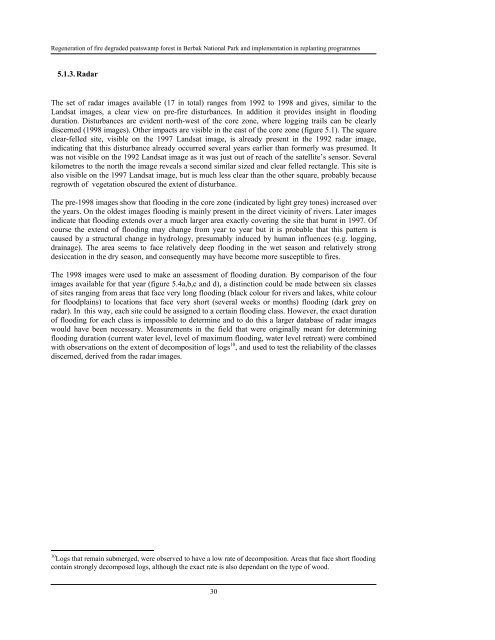Regeneration of fire degraded peatswamp forest in Berbak National ...
Regeneration of fire degraded peatswamp forest in Berbak National ...
Regeneration of fire degraded peatswamp forest in Berbak National ...
You also want an ePaper? Increase the reach of your titles
YUMPU automatically turns print PDFs into web optimized ePapers that Google loves.
<strong>Regeneration</strong> <strong>of</strong> <strong>fire</strong> <strong>degraded</strong> <strong>peatswamp</strong> <strong>forest</strong> <strong>in</strong> <strong>Berbak</strong> <strong>National</strong> Park and implementation <strong>in</strong> replant<strong>in</strong>g programmes<br />
5.1.3. Radar<br />
The set <strong>of</strong> radar images available (17 <strong>in</strong> total) ranges from 1992 to 1998 and gives, similar to the<br />
Landsat images, a clear view on pre-<strong>fire</strong> disturbances. In addition it provides <strong>in</strong>sight <strong>in</strong> flood<strong>in</strong>g<br />
duration. Disturbances are evident north-west <strong>of</strong> the core zone, where logg<strong>in</strong>g trails can be clearly<br />
discerned (1998 images). Other impacts are visible <strong>in</strong> the east <strong>of</strong> the core zone (figure 5.1). The square<br />
clear-felled site, visible on the 1997 Landsat image, is already present <strong>in</strong> the 1992 radar image,<br />
<strong>in</strong>dicat<strong>in</strong>g that this disturbance already occurred several years earlier than formerly was presumed. It<br />
was not visible on the 1992 Landsat image as it was just out <strong>of</strong> reach <strong>of</strong> the satellite’s sensor. Several<br />
kilometres to the north the image reveals a second similar sized and clear felled rectangle. This site is<br />
also visible on the 1997 Landsat image, but is much less clear than the other square, probably because<br />
regrowth <strong>of</strong> vegetation obscured the extent <strong>of</strong> disturbance.<br />
The pre-1998 images show that flood<strong>in</strong>g <strong>in</strong> the core zone (<strong>in</strong>dicated by light grey tones) <strong>in</strong>creased over<br />
the years. On the oldest images flood<strong>in</strong>g is ma<strong>in</strong>ly present <strong>in</strong> the direct vic<strong>in</strong>ity <strong>of</strong> rivers. Later images<br />
<strong>in</strong>dicate that flood<strong>in</strong>g extends over a much larger area exactly cover<strong>in</strong>g the site that burnt <strong>in</strong> 1997. Of<br />
course the extend <strong>of</strong> flood<strong>in</strong>g may change from year to year but it is probable that this pattern is<br />
caused by a structural change <strong>in</strong> hydrology, presumably <strong>in</strong>duced by human <strong>in</strong>fluences (e.g. logg<strong>in</strong>g,<br />
dra<strong>in</strong>age). The area seems to face relatively deep flood<strong>in</strong>g <strong>in</strong> the wet season and relatively strong<br />
desiccation <strong>in</strong> the dry season, and consequently may have become more susceptible to <strong>fire</strong>s.<br />
The 1998 images were used to make an assessment <strong>of</strong> flood<strong>in</strong>g duration. By comparison <strong>of</strong> the four<br />
images available for that year (figure 5.4a,b,c and d), a dist<strong>in</strong>ction could be made between six classes<br />
<strong>of</strong> sites rang<strong>in</strong>g from areas that face very long flood<strong>in</strong>g (black colour for rivers and lakes, white colour<br />
for floodpla<strong>in</strong>s) to locations that face very short (several weeks or months) flood<strong>in</strong>g (dark grey on<br />
radar). In this way, each site could be assigned to a certa<strong>in</strong> flood<strong>in</strong>g class. However, the exact duration<br />
<strong>of</strong> flood<strong>in</strong>g for each class is impossible to determ<strong>in</strong>e and to do this a larger database <strong>of</strong> radar images<br />
would have been necessary. Measurements <strong>in</strong> the field that were orig<strong>in</strong>ally meant for determ<strong>in</strong><strong>in</strong>g<br />
flood<strong>in</strong>g duration (current water level, level <strong>of</strong> maximum flood<strong>in</strong>g, water level retreat) were comb<strong>in</strong>ed<br />
with observations on the extent <strong>of</strong> decomposition <strong>of</strong> logs 10 , and used to test the reliability <strong>of</strong> the classes<br />
discerned, derived from the radar images.<br />
10 Logs that rema<strong>in</strong> submerged, were observed to have a low rate <strong>of</strong> decomposition. Areas that face short flood<strong>in</strong>g<br />
conta<strong>in</strong> strongly decomposed logs, although the exact rate is also dependant on the type <strong>of</strong> wood.<br />
30

















![CynefinFramework final [Read-Only]](https://img.yumpu.com/19017304/1/190x135/cynefinframework-final-read-only.jpg?quality=85)